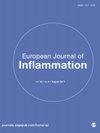claudin家族成员在透明细胞肾细胞癌中的表达及预后价值的综合分析
IF 0.8
4区 医学
Q4 IMMUNOLOGY
引用次数: 0
摘要
目的:透明细胞肾细胞癌(ccRCC)占所有肾癌的80%,预后不良。研究发现,claudins(CLNDs)的异常表达会影响紧密连接(TJs)的功能,并在各种上皮恶性肿瘤中恶性肿瘤的发生、发展和转移中发挥重要作用。然而,人们对不同CLND在ccRCC中的作用知之甚少。方法:采用GEPIA、UALCAN、HPA、Kaplan-Meier绘图仪、cBioPortal、StringDB、GeneMANIA、Metascape和TIMER数据库进行数据采集。结果:在ccRCC受影响的组织中,CLDN7、8、10、11、14、16和19的表达水平显著降低,启动子高度甲基化。低表达水平的ccRCC患者与临床癌症分期、肿瘤分级和总生存率低高度相关。蛋白质相互作用和富集分析表明,CLDNs的差异表达主要与上皮细胞分化和细胞粘附调节有关。此外,CLDNs的差异表达与不同免疫细胞的浸润显著相关,包括ccRCC中的六种类型的CD4+T细胞、巨噬细胞、中性粒细胞、B细胞、CD8+T细胞和树突状细胞。结论:它们有望作为预测ccRCC患者预后的生物标志物。本文章由计算机程序翻译,如有差异,请以英文原文为准。
Comprehensive analysis of the expression and prognosis value of claudin family members in clear cell renal cell carcinoma
Objective: Clear cell renal cell carcinoma (ccRCC) accounts for 80% of all renal cancers and has a poor prognosis. Studies have found that the abnormal expression of claudins (CLNDs) can influence the functions of tight junctions (TJs) and plays an important role in the occurrence, development, and metastasis of malignant tumours in a variety of epithelial malignant tumours. However, the roles of the different CLNDs in ccRCC are poorly understood. Methods: Used the GEPIA, UALCAN, HPA, Kaplan-Meier Plotter, cBioPortal, String-DB, GeneMANIA, Metascape, and TIMER databases to collect data. Results: The expression levels of CLDN7, 8, 10, 11, 14, 16, and 19 were significantly reduced and promoters were hypermethylated in ccRCC-affected tissues. ccRCC patients with low expression levels are associated highly with the clinical cancer stages, tumour grades, and poor overall survival. Protein interaction and enrichment analysis showed the differential expressions of CLDNs were primarily associated with epithelial cell differentiation and regulation of cell adhesion. Moreover, differential expressions of CLDNs were significantly correlated with the infiltration of diverse immune cells, including six types of CD4+ T cells, macrophages, neutrophils, B cells, CD8+ T cells, and dendritic cells in ccRCC. Conclusion: They are expected to serve as biomarkers for predicting the prognosis of ccRCC patients.
求助全文
通过发布文献求助,成功后即可免费获取论文全文。
去求助
来源期刊
CiteScore
0.90
自引率
0.00%
发文量
54
审稿时长
15 weeks
期刊介绍:
European Journal of Inflammation is a multidisciplinary, peer-reviewed, open access journal covering a wide range of topics in inflammation, including immunology, pathology, pharmacology and related general experimental and clinical research.

 求助内容:
求助内容: 应助结果提醒方式:
应助结果提醒方式:


